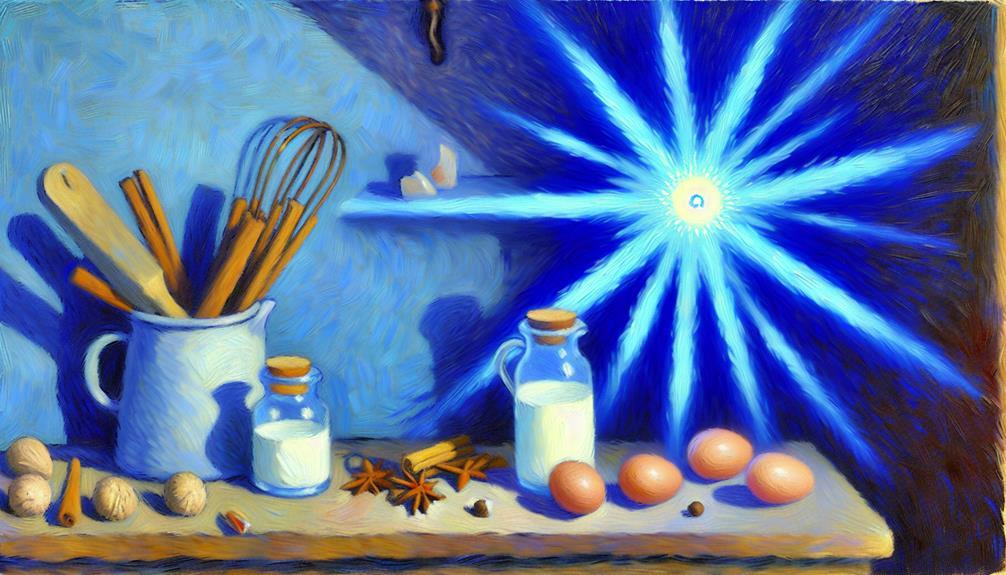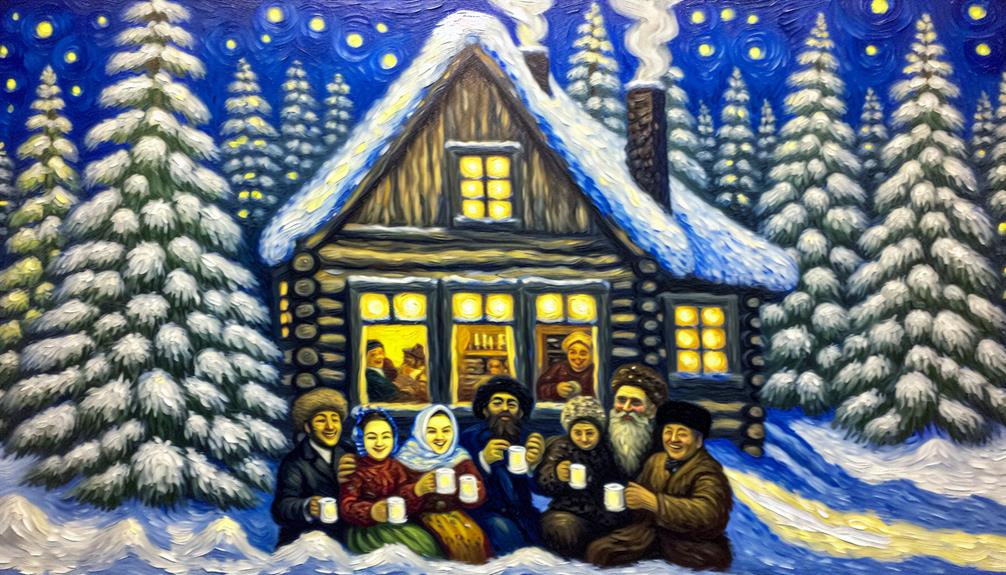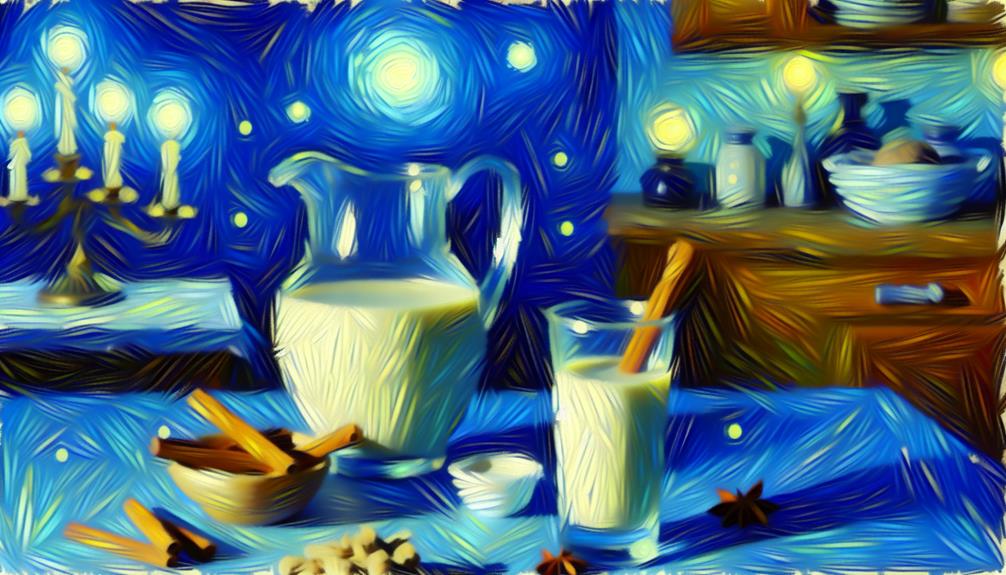Eggnog became a beloved Christmas drink thanks to its rich history and festive ingredients. Originally a medieval British concoction called posset, made from milk, eggs, and ale or wine, it shifted across the Atlantic, becoming popular in the American colonies with rum replacing ale. This creamy mix of beaten eggs, milk, sugar, and seasonal spices like nutmeg became synonymous with holiday cheer, symbolizing warmth and prosperity. Its luxurious, festive feel makes it perfect for Christmas celebrations, evoking fond memories and bringing people together. From historical roots to cultural significance, eggnog‘s story is as rich as its taste—there’s much more to know about this holiday favorite.
Takeaways
- Eggnog’s rich ingredients and festive spices evoke the warmth and abundance associated with Christmas celebrations.
- Introduced to the American colonies in the 18th century, eggnog became a holiday tradition due to its luxurious and celebratory nature.
- The use of seasonal spices like nutmeg and cinnamon connects eggnog to historical holiday traditions and winter festivities.
- Eggnog’s nostalgic charm and creamy texture make it a beloved part of family gatherings and holiday parties.
Historical Origins
Eggnog’s historical origins can be traced back to Medieval Britain, where it evolved from a drink called posset, a concoction made from milk, eggs, and often flavored with ale or wine. This early version of eggnog was a favorite among monks and the wealthy due to its rich ingredients and was used as a remedy for colds and a luxurious nightcap.
The drink made its way to the American colonies in the 18th century, where it quickly became popular, especially among the affluent. In the colonies, the recipe adapted to the availability of local ingredients, with rum often replacing the ale or wine. The inclusion of egg yolks, a symbol of wealth and abundance, made eggnog a fitting holiday drink.
Traditional Ingredients

When it comes to traditional eggnog, the star ingredients are a rich blend of eggs, milk or cream, and sugar, creating its signature creamy texture.
Classic seasonal spices like nutmeg and cinnamon add that unmistakable festive flair.
Often, a splash of rum, bourbon, or whiskey is included, giving the drink its warm, celebratory kick that makes it a holiday favorite.
Key Eggnog Components
Traditional eggnog is crafted from a rich blend of beaten eggs, milk or cream, sugar, and an array of seasonal spices. This luscious combination creates a beverage that is synonymous with holiday cheer. The eggs play a vital role, lending a custard-like texture that makes eggnog so indulgent. Combined with creamy milk or luxurious cream, the mixture achieves a richness that is simply irresistible.
Sugar, the sweet component, balances the flavors and contributes to the drink’s decadence. Seasonal spices, including freshly grated nutmeg, enhance the holiday spirit by infusing the drink with warmth and complexity. This blend of ingredients, steeped in tradition, guarantees that eggnog is a perennial favorite during the festive season.
Alcohol, although optional, is often added to eggnog for an extra layer of warmth and festivity. Rum, bourbon, or brandy are popular choices, each imparting its own unique flavor. For those who prefer a non-alcoholic version, the traditional recipe still stands strong, offering a delightful treat.
Store-bought eggnog often uses pasteurized eggs, guaranteeing safety while maintaining the classic texture. This careful crafting of ingredients makes eggnog a quintessential holiday beverage, cherished by many.
Classic Seasonal Spices
Classic seasonal spices, such as nutmeg, cinnamon, and cloves, play an indispensable role in defining the rich and festive flavor of traditional eggnog. These spices evoke the warmth of winter festivities, making eggnog synonymous with the Christmas holiday season. Nutmeg, a key ingredient, has been intertwined with holiday traditions since the 17th century, emphasizing its deep-rooted significance in Christmas celebrations.
The combination of eggs, milk, and sugar in eggnog creates a custard-like texture that is perfectly complemented by these spices. Freshly grated nutmeg, in particular, adds a distinctive aroma and taste, making it a hallmark of traditional eggnog recipes. The practice of using such luxurious spices during festive occasions symbolizes celebration and prosperity, reflecting historical customs.
Incorporating these spices not only enhances the flavor but also connects us to the rich history and traditions of holiday celebrations.
| Spice | Role in Eggnog | Historical Significance |
|---|---|---|
| Nutmeg | Adds distinctive aroma and taste | Associated with Christmas since 17th century |
| Cinnamon | Provides warmth and depth | Commonly used in winter festivities |
| Cloves | Adds a sweet and spicy note | Symbolizes luxury and celebration |
American Popularity
Eggnog’s rise in popularity within American colonies during the 19th century can be attributed to its adaptation from British origins to suit local ingredients and tastes. Initially a British concoction, eggnog quickly became a beloved part of Christmas celebrations in the American colonies. The colonists adapted the recipe to include locally available spirits like rum and whiskey, making it a festive choice during the winter season. This new version of eggnog became a staple at holiday gatherings, cementing its place in the hearts and homes of many.
During the 1700s and 1800s, eggnog found its way into countless Christmas festivities, turning into a cherished holiday tradition. Families would gather around, sipping this creamy delight, celebrating the warmth of the season. The drink’s rich, comforting flavors made it a perfect companion for the cold winter nights, encouraging its widespread acceptance.
Today, the tradition of serving eggnog during Christmas has endured. It’s estimated that Americans spend around $185 million annually on this holiday staple, highlighting its continued significance. The journey of eggnog from a British import to an American favorite underscores its lasting appeal and enduring role in holiday celebrations.
Cultural Significance

The enduring popularity of eggnog in American holiday traditions underscores its deep cultural significance as a symbol of warmth and togetherness. This creamy holiday beverage, with its rich blend of eggs, milk, and sugar, enhanced by spices like cinnamon and nutmeg, has been a staple since the 1700s. Originally enjoyed by wealthy British aristocrats, eggnog crossed the Atlantic and took root in American colonial traditions, becoming a cherished part of Christmas celebrations.
Eggnog’s cultural significance lies in its ability to evoke the spirit of the holiday season. The comforting flavors and aromatic spices create a sensory experience that brings back fond memories of family gatherings and festive parties. This nostalgic charm is why eggnog is often served at family reunions and Christmas parties, reinforcing its role as a drink that brings people together.
Moreover, eggnog’s presence in modern holiday traditions, such as themed parties and seasonal products, further cements its legacy as an iconic Christmas drink. Its enduring appeal highlights the importance of tradition and the joy of shared experiences, making eggnog more than just a beverage—it’s a cherished symbol of the holiday spirit.
Holiday Associations

Eggnog is intrinsically linked to Christmas celebrations, embodying the festive spirit through its rich flavors and historical significance. Originating in the 1700s, eggnog became a staple in American colonies during the winter months, symbolizing warmth and prosperity. The drink’s luxurious ingredients and creamy texture made it a perfect fit for the joyous Christmas season.
The connection between eggnog and Christmas has been reinforced by several historical and cultural factors:
- Special Occasions: Eggnog, with its sweet and rich flavor profile, often enhanced with spices like cinnamon and nutmeg, is ideal for holiday parties. Its festive taste and warming qualities make it a favorite during cold winter nights.
- Historical Legacy: George Washington served his own version of eggnog at Mount Vernon during Christmas, cementing its association with the holiday. This tradition elevated eggnog to a status symbol of festive cheer and hospitality.
- Modern Traditions: Today, eggnog remains a holiday staple, with Americans spending approximately $185 million on it annually. Its presence at Christmas gatherings reflects both historical continuity and contemporary enjoyment.
These factors guarantee that eggnog continues to be celebrated as a quintessential Christmas drink, embodying the spirit of the season.
Health Considerations

When enjoying a festive glass of eggnog, it’s important to take into account its nutritional profile and the safety of raw eggs.
While rich and creamy, eggnog is high in calories and sugar, so moderation is key.
Additionally, homemade versions with raw eggs can pose health risks, but using pasteurized eggs can make your holiday treat safer.
Eggnog’s Nutritional Profile
With its high calorie and fat content, eggnog poses notable health considerations for individuals mindful of their dietary intake. Eggnog, a classic Christmas beverage, is cherished for its rich, creamy texture and festive appeal. However, a standard serving of store-bought eggnog contains approximately 223 calories and 11 grams of fat, making it a high-calorie treat. Additionally, traditional recipes often include raw eggs, which can be a health concern if not handled properly.
To better understand the nutritional profile of eggnog, consider the following:
- Calories and Fat: Eggnog’s high-fat content considerably contributes to its caloric density. This can be a concern for those monitoring their calorie intake during the indulgent holiday season.
- Sugar Content: Commercial varieties of eggnog can contain around 20 grams of sugar per serving, adding to the drink’s overall sweetness and potential health impact.
- Alcohol: Homemade eggnog often contains alcohol, which can further increase its caloric content. Some versions may exceed 20% alcohol by volume (ABV), making it essential to consume in moderation.
While eggnog is a delightful part of Christmas traditions, it’s important to enjoy it responsibly, keeping these nutritional factors in mind.
Safety of Raw Eggs
Consuming raw eggs in homemade eggnog can pose considerable health risks, particularly due to the potential for salmonella infection. Salmonella is a type of bacteria that can cause food poisoning, leading to symptoms like stomach cramps, diarrhea, and fever. This risk is especially concerning for vulnerable groups, such as young children, pregnant individuals, and older adults, who may experience more severe symptoms.
To mitigate these risks, many store-bought eggnogs use pasteurized eggs. Pasteurization involves heating the eggs to a specific temperature that kills harmful bacteria without cooking the egg, thereby guaranteeing safety while maintaining the flavor and texture we love.
When making homemade eggnog, opting for pasteurized liquid eggs is a wise choice. This practice considerably reduces the risk of salmonella, allowing you to enjoy your festive drink safely.
Always check labels for pasteurization information when purchasing eggnog. This guarantees the product meets safety standards for consumption. If you prefer homemade eggnog, pasteurized eggs are your best bet for a delicious and safe holiday treat.
Non-Dairy Alternatives

Increasingly, consumers are turning to non-dairy alternatives for their holiday eggnog, driven by health concerns, dietary restrictions, and the rise of veganism.
With more people adopting plant-based diets and seeking lactose-free options, brands like So Delicious and Silk have stepped up to offer dairy-free holiday nogs. These non-dairy alternatives are crafted from almond, coconut, or oat milk, making them suitable for a wider audience, including those who are lactose-intolerant or vegan.
Non-dairy eggnogs don’t compromise on the classic creamy texture or rich flavor. They often incorporate seasonal spices like nutmeg and cinnamon, ensuring that the festive spirit remains intact even without traditional dairy.
The growing demand for such products highlights a significant shift in consumer preferences, with many willing to invest in premium options that align with their health-conscious lifestyles.
Some notable trends in the non-dairy eggnog market include:
- Increased Variety: Brands are expanding their offerings, providing more flavors and types of non-dairy eggnog.
- Enhanced Quality: Many products now boast a creamier texture and richer flavor, closely mimicking traditional eggnog.
- Seasonal Appeal: These alternatives maintain traditional holiday spices, keeping the festive charm alive.
As the market for non-dairy alternatives continues to grow, it’s clear that eggnog’s festive allure is here to stay, albeit in a more inclusive form.
Frequently Asked Questions
Why Do We Drink Eggnog on Christmas?
Eggnog is traditionally consumed during Christmas due to its historical association with prosperity and celebration. Its rich ingredients and George Washington’s endorsement further cemented its status as a festive beverage enjoyed during holiday gatherings.
Why Is Eggnog Only Sold During Christmas?
Eggnog is primarily sold during Christmas to align with consumer demand, as it is culturally perceived as a festive beverage. Its limited seasonal availability enhances its exclusivity, reinforcing its identity as a quintessential holiday drink.
Why Do Americans Love Eggnog?
Americans love eggnog due to its rich, sweet, and spiced flavor profile, which evokes warmth and festivity. Its cultural significance, bolstered by traditional family recipes and holiday customs, enhances its popularity during the Christmas season.
Why Is Eggnog so Addictive?
Eggnog’s addictive nature stems from its rich, creamy texture, sweet flavor, and comforting spices, which create pleasurable brain responses. Additionally, its high-fat content and nostalgic holiday associations enhance its appeal and drive seasonal cravings.
Conclusion
Eggnog’s reputation as a Christmas drink is deeply rooted in its historical origins, traditional ingredients, and cultural significance.
Its American popularity, bolstered by holiday associations, has cemented its place during festive celebrations.
Despite health considerations, the beverage continues to be cherished, with non-dairy alternatives ensuring inclusivity.
The rich history and beloved traditions surrounding eggnog make it more than just a drink; it is a symbol of holiday cheer and togetherness.













